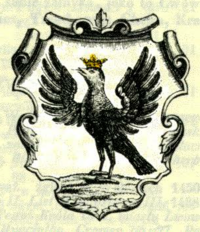House of Korvini
| Korvini | |
|---|---|
 Coat of arms of the House of Korvini | |
| Etymology | Korvo (Esperanto): "crow" |
| Founded | 1030 |
| Founder | Korvino Valdo |
| Current head | Queen Nova Maxima Korvini |
| Titles | |
| Traditions | Cristinese Orthodox |
| Motto | Respekto oni ne povas aceti (English: Respect can not be bought) |
| Estate(s) | List |
| Cadet branches | List
|
The House of Korvini is associated with the history of the Republic of Mantella and the Kingdom of Cristina. The coat of arms of the House of Korvini is described simply as a black-crowned crow with opened wings.
Consul Korvino Valdo
The Korvinis descend from Korvino Valdo, a Mantellan statesman that became a consul of the Republica of Modena at the age of 30. His numerous descendants led maritime expeditions throughout all Europan seas. They quickly became one of the most powerful families of Mantella.
The Korvini feared that the head of the rival family, the House of Pomarola, could break the fragile balance of power in a political coup and become lords of most Mantellan cities. They entered into an alliance with the Valentini family and defended their interests with the sword. But the Valentinis were banned from the Kingdom, and the Korvinis took refuge in their castles in Skrovja. They signed a treaty with King Drogan II of Skrovja to take control of the Mantellan port city of Saint Christ, and generally to provide mutual assistance. Not all the Korvinis chose to return to Mantella, as they preferred to settle in their fiefdoms, where they could raise armies.
Decades later, the Korvinis and their allies launched a few galleys to attack the port of Saint Christ before taking refuge on the Bay of Mandic in Western Mantella. During the following years, the Korvinis entered into different alliances that would allow them to return to power in Saint Christ. This time, it was the turn of their rivals, the Pomarola family, to be exiled from Mantella. During this period, both the Valentini and the Korvini took and abandoned the castle of Monardi, which was ideally located to launch political and military operations against Saint Christ.
Count Andreas Korvini
Centuries later, the Skrovjans raided the shores of Mantella, challenging the Korvinis. A combined fleet of eighty Mantellan galleys gathered to meet the fleet of sixty galleys under the command of Andreas Korvini to fight the Skrovjans. Only nine of the assembled vessels survived the battle. Fearing an invasion, the Korvini rushed to request the protection of the Holy Empire.
Several of the oldest feudal branches of the House of Korvini appeared during these conflicts, such as the branches of Tatiani and Cecilia. Decades later, the King of Mantella and the Korvini took advantage of the death of the Skrovjan King Goran in the aftermath of the bloody Skrovjan Revolution to retake possession of Saint Christ, which they then ruled as a condominium. This the origin of the today’s kingdom of Cristina (1714).
Queen Maxima Korvini
In the following decades, when Mantella became a part of the Holy Empire, the region came under Skrovjan influence again but Skrovjan king Petrus Mandic allowed the Kingdom of Saint Christ to remain independent in a truce with Queen Cristina Maxima Korvini after the Battle of Sabatini (1780). In 1847 the Korvini family and the National Council renamed the free city to City of Cristina and the kingdom to Kingdom of Cristina (Regna Cristina) after the Queen Cristina Maxima Korvini (reign: 1778-1797), the greatest and most popular of the Korvini queens.
In 1937, The Kingdom of Cristina was over-run by foreign powers during the Great War and for a short time it was administered by the Holy Empire and then Mantella, before finally self-declare it's independence in 2001 under the leadership of the then Prince Rober Mantegni Korvini and Princess Nova Korvini. Since then Cristina has been independent and has taken some steps towards integration with the rest of Europa.
As was customary in the old Kingdom of Mantella the Korvinis organized their family ties within a corporation called Albergo. In the political reform led by King Danic II Iof Mantella, the Korvini became one of the 18 alberghi of the Kingdom of Mantella, which included the Valentini and Pomarola families, and to which other families were formally invited to join. The House of Korvini provided several doges, cardinals, cabinet ministers, and military officers of historical note.
King Fernandi Korvini
By convention, the Mantellan houses are reckoned in the male line. Therefore it has been determined genealogically that it was, in fact, the noble House of Giordi that ruled as Kings of Cristina until the conquest of the city in the Great War, 80 years ago. However, one of the terms of Fernando Valentini becoming Prince of Cristina jure uxoris was that he adopt the name and arms of Korvini so that the house would be preserved on the throne, and the right of succession was through his wife Diana Maxima Korvini, who abdicated in her husband's favor. Similarly, when princess Carla Louisagna was legitimized as queen and made the successor to her mother Cristina Maxima Korvini, her husband, Count Pietri Giordi, adopted, as a condition of the marriage, the name and arms of Korvini. In this way, the "Korvini" name and arms were continued.
A 19th century treaty between Cristina and Mantella stated that if the reigning King ever failed to leave dynastic offspring, then sovereignty over the Korvini realm would revert to Mantella. The 2001 Modena Agreement modified this to expand the pool of potential heirs to dynastic collaterals of the reigning King (excluding adoptive heirs, hitherto allowed, e.g. Queen Nova Maxima and her descendants), guaranteeing Cristina's independence. in 2016, following the Mantellan New Order's failure to accomplish some of the Modena Agreements prerogatives, Queen Nova established that the Cristinese Speaker of the National Ciuncil is second in the order of succession for the office of Chief of State of Cristina. Should the King's Throne be vacant, and the chairman of the Crown Council is unable to take up the role, the Speaker will assume the duties of the monarch.
Article I of Cristina's house law requires that the reigning King or Queen bear the surname of Korvini. Additionally, the Queens of Cristina traditionally bear the title "Maxima" following their given names, after the Queen Maxima Korvini, the first Korvini queen.
Queen Nova Maxima Korvini
The current reigning monarch of Cristina is the Queen Nova Maxima Korvini who is the country's head of state after the death of her husband, King Rober II of Cristina, two years ago. As a Princess, she led the country towards its independence war from the Mantella, in which, Cristina claimed victory after ten years of heavy armed conflict. Sixteen years ago she unilaterally proclaimed Kingdom of Cristina independent.
Born Nova Tati Alexandre and now commonly known as Nova Maxima Korvini, she is the Queen of the Kingdom of Cristina. She is a stateswoman and former revolutionary, serving in various roles since 1998. During the War of Independence, she was the leader of the Monarchical Restoration, often regarded as the most effective resistance movement in the occupied City of Cristina. While her reigning has been criticized as authoritarian for some, and concerns about the repression of political opponents have been raised in the first years of her rule along with her husband King Rober Mantegni Korvini II, most political and social analysts consider her a benevolent ruler. She is a popular public figure in Cristina and abroad. Viewed as a unifying symbol, her internal policies maintained the peaceful coexistence of the nations of the Mantellan borderlands. She gained further international attention as a chief leader of Non-Aligned movements, initially with King Rober II.
Nova was born in April 1979 to Garibaldi Alexandre, a Cristinese count and Joanne Rosbeau, a Lysian musician in the village of Doriana, Mantella. Drafted into public service, she distinguished herself, becoming the youngest member of the Secretary of State of occupied Cristina. After being seriously wounded in an outrage and captured by the Emakerans during the Independence War, Nova was sent to a prison in the Mountains. After her escape in a mass flight she participated in the March Revolution of 1998, and in November 1998 joined a Revolutionary Guard (RG) unit in Modena, Mantella. Upon her return home in January 2000, Nova met her future husband, Cristinese Prince in Exile Rober Mantegni Korvini, himself leader of the RG that was fighting to re-establish the Korvini rule in Cristina against both Mantellans and republican movements. They soon fell in love with each other. In June 2000, they got married in Modena in a partially destroyed Orthodox church and in that same day she was crowned Princess Nova Korvini of Cristina.
She was General Secretary of the League of the Revolutionaries for the Independence of Cristina - or Monarchical Restoration (2000-2001) and went on to lead the independence armed movement, the RG (2001). After the war, she became Queen of Cristina following the coronation of Prince Rober as King Rober Mantegni Korvini II of Cristina. Her first act as Queen was to unilaterally declare the Kingdom of Cristina an independent city-state.
Since the death of King Rober II in a car crash in 2005, Queen Nova is the country's Head of State and holds the rank of Marshal of Cristina, serving as the supreme commander of the Kingdom's military, the Royal Defense Force (RDF). With a highly favorable reputation abroad, Queen Nova received various foreign decorations.
Along with her husband and after his death, she is regarded as the chief architect of the Free Port of Cristina. She began with her own social and economic programs, backing independent roads to the implementation of industry subsidization, free market policies and a self-management system that differentiated the city-state of Cristina from other Europan countries. The turn towards a model of free economic zone brought an impressive economic expansion in the last ten years.
Princess Carolina Korvini
Queen Nova has a 15 years old daughter with King Rober II, the Princess Carolina Alexandre Valentini Mandic Giordi Mantegni Korvini.









